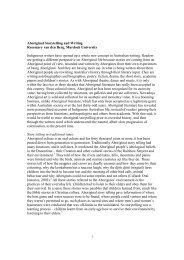'Fuck All Editors': The Ern Malley Affair and Gwen ... - [API] Network
'Fuck All Editors': The Ern Malley Affair and Gwen ... - [API] Network
'Fuck All Editors': The Ern Malley Affair and Gwen ... - [API] Network
- No tags were found...
Create successful ePaper yourself
Turn your PDF publications into a flip-book with our unique Google optimized e-Paper software.
Cass<strong>and</strong>ra Athertonstaff correspondent responding to the hoax in a subsequent edition of the Bulletincondescending that Harwood had ‘apparently imagined that the acrostic wouldremain her private secret forever. Such are the fantasies of lady poets’. 27 In herdefence, Harwood continued to argue that it was the typesetter who first noticed it<strong>and</strong> that she had no intention of exposing the ‘foul acrostic’. 28 However, there isevidence to suggest that it was the staff <strong>and</strong> students at Melbourne University whofirst detected the scam, prompted by Vincent Buckley, who in turn had been tippedoff by Harwood. 29Harwood’s sonnets ‘Eloisa to Abelard’ <strong>and</strong> ‘Abelard to Eloisa’ typify theferocity of emotion inherent in the poetry written under the pseudonym WalterLehmann. Much more has been written on the acrostic embedded in these sonnetsthan on the artistic merits of the sonnets themselves. It was popular to believe, inline with Harwood’s judgement, that the poems were indeed ‘poetical rubbish’.Harwood’s view of these poems is much more scathing than contemporaryanalyses of their merits. Trigg <strong>and</strong> Hoddinott emphasise the positive use of meter<strong>and</strong> imagery in the sonnets. Hoddinott states that the sonnets are ‘poems ofmusical mellifluousness, full of words poetically evocative of loss <strong>and</strong> despair’,but then concludes that they are ‘almost completely devoid of overall sense’. 30Trigg is more favourable in her analysis <strong>and</strong> argues that the poems ‘fulfil [the]technical requirements of a sonnet, <strong>and</strong> include ... a small h<strong>and</strong>ful of powerfulimages, even if they do rather tumble over one another’. 31 If the sonnets aredeemed to be well crafted pieces, then the impact of Harwood’s irreverence isdiminished. <strong>The</strong> publication of these two sonnets in the Bulletin has been read,Trigg argues, as ‘an example of the anti-establishment resistance’. 32 Horne couldnot detect a hoax or indeed a bad poem when he came across one. <strong>The</strong> two sonnetshave some literary merit <strong>and</strong>, if Harwood had not prompted Vin Buckley to read<strong>and</strong> publicly identify the acrostic, they may well have stood as two mediocrepoems written by a passionate male poet.<strong>The</strong> characters Eloisa <strong>and</strong> Abelard are an interesting choice. Known for theirpassionate correspondence <strong>and</strong> taboo relationship, they are a conscious choice forHarwood <strong>and</strong> specifically for the subpersonality Walter Lehmann. In the firstsonnet, ‘Eloisa to Abelard’, which spells acrostically ‘So lOng bULLetIN’,Harwood explores the themes of exile <strong>and</strong> spiritual struggle, especially whentempted by desire. In a dramatic monologue, Eloisa expresses her torturousfeelings of loss to Abelard. Though some of the lines are a little stilted, the line‘You/ shall find/ loss, absence, nothing’ clearly captures the double void Eloisafeels at being separated from her beloved <strong>and</strong> her remorse at the betrayal of herreligion. Similarly, the richness of images in the second stanza conveys thesharpness of loss. <strong>The</strong> words ‘My wound/ is you’ speaks of an intense <strong>and</strong> physicalpain <strong>and</strong> suffering at the heart of their separation, just as a wound by its verynature separates tissue. <strong>The</strong> mention of a ‘wound’ also overlays the imagery withthe pain of ab<strong>and</strong>oning her religious beliefs to lust. <strong>The</strong> final line of the last stanzais also a powerful indictment of physical <strong>and</strong> spiritual love: ‘No heart escapes thetorment of its choice’. 33Abelard replies to Eloisa in the second sonnet that acrostically spells ‘Fuck AlLeDiToRs’. As the male, Abelard is stereotypically characterised as stronger thanEloise <strong>and</strong> less blinded by romantic love. His dramatic monologue privileges his155


!['Fuck All Editors': The Ern Malley Affair and Gwen ... - [API] Network](https://img.yumpu.com/42446228/5/500x640/fuck-all-editors-the-ern-malley-affair-and-gwen-api-network.jpg)
![Dream and Nightmare in William Gibson's ... - [API] Network](https://img.yumpu.com/49298598/1/184x260/dream-and-nightmare-in-william-gibsons-api-network.jpg?quality=85)

![Polona Petek - [API] Network](https://img.yumpu.com/40542952/1/190x245/polona-petek-api-network.jpg?quality=85)
![to download as a PDF. - [API] Network](https://img.yumpu.com/35170825/1/184x260/to-download-as-a-pdf-api-network.jpg?quality=85)
![Edward Koiki Mabo: The Journey to Native Title - [API] Network](https://img.yumpu.com/33197148/1/184x260/edward-koiki-mabo-the-journey-to-native-title-api-network.jpg?quality=85)
![Gallipoli, Kokoda and the Making of National Identity - [API] Network](https://img.yumpu.com/31766380/1/184x260/gallipoli-kokoda-and-the-making-of-national-identity-api-network.jpg?quality=85)
![Indigenous Knowledge and Pharmaceuticals - [API] Network](https://img.yumpu.com/24108846/1/184x260/indigenous-knowledge-and-pharmaceuticals-api-network.jpg?quality=85)
![Ferals: Terra-ism and Radical Ecologism in Australia - [API] Network](https://img.yumpu.com/13809010/1/184x260/ferals-terra-ism-and-radical-ecologism-in-australia-api-network.jpg?quality=85)
![Big Chief Little Wolf: Wrestling, Radio and Folklore in ... - [API] Network](https://img.yumpu.com/12204748/1/184x260/big-chief-little-wolf-wrestling-radio-and-folklore-in-api-network.jpg?quality=85)
![Dark Tourism and the Celebrity Prisoner - [API] Network](https://img.yumpu.com/4348795/1/184x260/dark-tourism-and-the-celebrity-prisoner-api-network.jpg?quality=85)